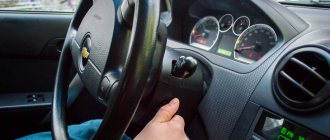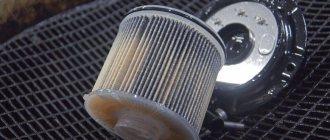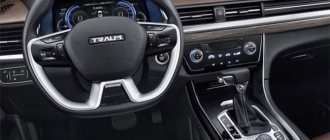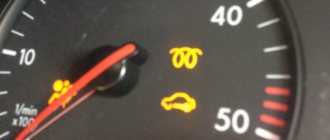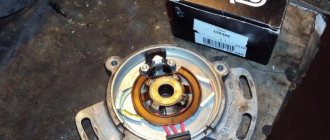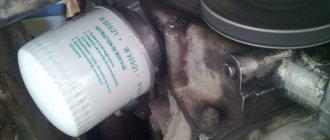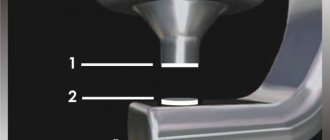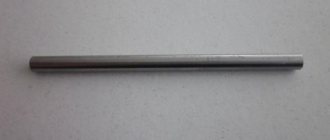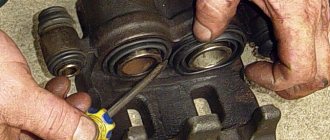Quite often, car enthusiasts find themselves in an unpleasant situation when their car does not start on its own due to a dead battery or starter malfunction.
In this situation, the easiest and most proven way to set the car in motion is to start it with a pushrod.
But, despite the prevalence of this method, few people know that if done incorrectly, it can lead to rather dire consequences for the car. This article describes how to start your car without damaging the engine.
Why push the car?
First, a little job description. The engine starts by turning the crankshaft.
On a working car, its movement (and the movement of other necessary parts) is initiated by the starter.
But sometimes, due to malfunctions, you can use the starter for hours without any benefit. Then towing comes to the rescue.
When the drive wheels move, even forcibly, the torque is supplied through the transmission to the shaft. This allows you to start the car.
The problem itself usually occurs due to a weak battery charge. If the battery produces excessively low current, the crankshaft will turn more slowly and harder.
When the charge is completely depleted, you can only hear the usual clicks. Both the starter and another ignition unit can break down.
Finally, if the device does not respond at all to turning the key, there is an open circuit or a fault with the contacts.
In all of the above cases, pushing the car is the only way to try to start it.
Diesel and injection engines
Since the pusher method is optimal only for carburetor engines with a manual transmission, drivers are interested in whether it is possible to start an injection and diesel car with a pusher.
If you have an injection engine or a motor running on diesel fuel, you can try to start the car using the same method as in the case of carburetor power plants. But here it is important to understand that diesel and injector are highly sensitive. Because of this, the risk of breaking some components and parts during towing increases.
When a tugboat starts a diesel engine, it encounters serious loads on the gas distribution mechanism. The indicators of these loads significantly exceed those experienced by the starter on a carburetor car. Therefore, an attempt to start the engine may result in partial or complete failure of the gas distribution mechanism and related components. If the motorist has no other option but to use the towing method, he can take a risk. But remember that in this situation it is necessary to push the vehicle in high gear mode. That is, the box should be switched to position 3 or 4 speeds.
If you have an injection engine with 8 valves, then you can safely use the carburetor method of starting the engine from a tug. There is no threat or potential damage to the machine.
Things are somewhat different with injection 16-valve engines. If problems arise with this engine, do not under any circumstances attempt to use the towing method. It is contraindicated for such an engine and is very dangerous. If you break this rule, the converter or catalyst will probably break. In some cases, collisions between pistons and valves may occur.
Conditions under which a car can be started from a pushrod
From the very beginning it is worth clarifying what kind of car we mean. So, to the question whether it is possible to start a car using a pusher, the answer will be negative.
More precisely, you can try to do this, and sometimes it will even work out well. However, the downside is that the transmission is almost guaranteed to be “killed”.
Such an act will be a way out of the situation only when “delay is like death.”
In all other situations, it is better not to guess whether the car can be started automatically from a pusher or not (especially since you will need a tow), but to use the services of a tow truck. This will be both easier and cheaper.
The next important point is to make sure that this does not create any interference or emergency situations. At the same time, even on the pushed vehicle itself, everything should be in order with the brakes and controls.
You can start a car manually using a pushrod with the help of 1-3 people. Much also depends on how easily the car starts on its own in normal mode.
The startup process may also be affected by:
- acceleration force;
- the skill of the drivers;
- engine's type;
- compression in pistons;
- motor temperature;
- condition of the driving part and tires;
- nature of the road.
Conditions for successful launch
The car engine is started by rotating the crankshaft with a starter powered by battery energy. If turning the key in the ignition switch results in silence or the sound of the starter working hard, it is recommended to stop trying so as not to completely drain the battery. The higher the charge level, the greater the chance of starting the engine.
To prevent pushing a car from turning into a grueling physical exercise and to produce results, consider the following points:
- It is unacceptable to start a car with an automatic transmission from a pusher and is fraught with expensive repairs.
- The number of assistants must correspond to the weight of the machine. If 2 people (including the driver) can push a small car, then an SUV or minibus requires 4–5 helpers.
- Before forcibly starting a car equipped with a carburetor power system and a mechanical fuel pump, be sure to pump up the fuel manually.
- Levers for manual pumping are also found on old diesel engines with a mechanical injection pump (stands for high pressure fuel pump). Use this handle to pre-pressurize the line.
- The injector and the new diesel engine, equipped with an electric pump, are very difficult to push and start “cold” if the battery charge is close to zero.
The last point requires clarification. For normal operation of diesel and injection nozzles, the electric fuel pump creates a certain pressure in the line. During long periods of machine inactivity, it gradually decreases. When the battery is completely dead, when the ignition is turned on, there is not enough energy to operate the pump, and the pressure in the system remains low. To lift it, you need to spin the generator, that is, you will have to push the car for a long time or drag it in tow. Sometimes it's easier to find a working battery .
The warning regarding cars with automatic transmission is not unfounded. It is useless to forcibly rotate the gearbox shafts from the wheel side - without oil pressure, the input shaft will not engage with the crankshaft. Unless you accelerate the car to a speed of 50 km/h and turn on the Drive mode, which will lead to instant failure of the friction discs. It is strictly not recommended to carry out such experiments - the launch is carried out exclusively from the battery.
How to properly start a car using a pushrod
To properly start a car with a manual pushrod, you should start by turning on the ignition.
If possible, you should move the car in the direction of a visually noticeable slope. It is important not to miss the moment of acceleration to 10-20 kilometers. Then squeeze the clutch and go into second gear.
Use the gas pedal as needed. After starting, the cars switch to neutral gear, if necessary, warm up the engine to operating temperature.
In winter, on snow, as well as on sand, gravel and regular dirt roads, it is better to engage not second, but 3rd gear. At second speed the wheels may slip.
Recommendations
- Regardless of the type of gearbox, you need to be very careful when starting a car using a pushrod. Loads on the clutch or torque converter, the box/transmission itself, as well as on the engine, timing belts and chains, accessory drive belts and a number of other elements can lead to breakdowns and a noticeable reduction in service life.
- Any problems with the starter or battery must be resolved promptly and in a timely manner so that during the operation of the car there are no problems with starting the power unit.
If you had to push the car, it is important to select the right gear when trying to start the engine, and also try to minimize the jerk during such a start. We also recommend reading the article on how to properly light a car. From this article you will learn how to light a car, as well as what to pay attention to when starting it. - In some cases, especially on a car with an automatic transmission, it is easier to try to start the engine with a faulty starter by connecting the starter directly (if this is possible and the problem is related to the electrical circuits and not the starter itself). If the battery is discharged, it is better to look for a starting charger or “light” the car from another car.
How to start a car alone
Having briefly understood the basic principles, we can answer this question. Then the driver will have to act independently.
The car is pushed, walking next to it, with the left door open, holding the steering wheel. After acceleration, they jump inside and quickly act in the same way as described above.
If the area is clear of other vehicles, it is easier to push from behind.
There is another option. After turning on the parking handbrake, jack up the drive wheel.
1.5 - 2 turns of a strong rope are wound onto it. When starting the ignition and second gear, you must sharply pull the cable to make the wheel spin.
If they fail, they repeat everything. If successful, turn off the gear and lower the jack.
All in your hands
You can try an exotic method in which the car remains in place and the suspended wheel spins. To do this, the car is raised on a jack, a rope or cable is wound around the wheel - the pulling movement is converted into a rotational movement, and it is transmitted to the crankshaft. Why such difficulties? If there is only one driver, conditions do not always allow you to push the car and accelerate it to the required speed in order to start the engine “from the pusher”. Here you can do it yourself.
But even in this case, you need to remember about safety precautions. If we put the car on a jack, do not forget to use the parking brake, and ideally put chocks under the remaining wheels. It should be taken into account that during the starting process the car may jump off the jack. If the engine starts at this moment, the car will start moving. The likelihood of this is especially high in the case of an all-wheel drive transmission and the presence of working locks. But if you have a single-wheel drive, a free differential, then there are no problems: the suspended wheel can be rotated, the second one will calmly stand on the ground without attempting to move.
But enough theory, let's check it in practice! We use a brand new cable especially for the experiment. It does not have metal hooks, which is also important: a hook or even just a tight knot can cause trouble in the arch when the wheel spins.
So, we put the car on a jack, tighten the handbrake, turn on the ignition, and first we’ll try to leave the gearbox in third gear. Here the relationship is as follows: the higher the gear, the easier it will be to spin the wheel, but the higher its rotation speed must be for the engine to “grab.” First attempt, second... Still not enough speed. Switching the box to the second...
It turned out to be surprisingly easy! Indeed, the engine started instantly, the car did not even make an attempt to escape. The method works! However, as far as we know, it does not always work. Much depends on technology. But in our case it worked.
Hey, in tow!
As you can see, you can start the engine even alone. Yet these methods are not always available. Then the classic is launch from a tug. It is almost inevitable if the engine is difficult to start, that is, the problem is not in the battery or starter, but, for example, in the fuel system, ignition or a faulty crankshaft sensor.
We won’t check anything here – everything is clear. Therefore, we will give some tips for those who are not experienced in towing, and especially in using this method of starting the engine.
If the towing eye is screw-in, it is important to screw it in completely, otherwise there is a risk of breaking it off at the thread. If you don’t have enough hand strength, you can use a lever - you can use a wheel wrench for this purpose.
It will also come in handy if your cable ends in a loop at the end rather than a hook. Just pull it through the eye and insert the same wheel wrench. Or carob. At the same time, it is important to make sure that this “stopper” does not dangle and does not touch the body. If this happens, you can make a knot in the cable and insert the key so as to avoid its contact with the car.
We talked in some detail about the rules and features of towing, but now we are interested in trying to start the engine. At the same time, it is also important to maintain tension on the cable in order to avoid jerking or running over the cable. Success depends on the coordinated actions of both drivers. The one who is on the tractor must show all his maneuvers in advance; the one who is in tow must remember that the power steering and brakes may not work. The driver of the leading car only indicates the need for braking, in extreme cases he helps, and the driver of the driven car brakes the entire train - this ensures the tension of the cable.
Now regarding the attempt to start the engine. It is best to do it on a straight section of a flat road, ideally with a good grip, but in winter this is not always possible. The correct choice of gear is important: it is better to proceed from the consideration that it should ensure engine operation in the range of 1000-2000 rpm. When engaging a gear, the clutch needs to work smoothly - and you should be prepared for the fact that on a slippery road at this moment the car may lead due to a sharp change in the speed of rotation of the wheels.
It is not always possible to start the engine even after several attempts. In some situations (for example, with flooded spark plugs), constant movement in the engaged gear for a long time can be used, similar to the cold run-in mode. In this case, the highest gear is selected with a short-term (when stopping at a traffic light, starting and accelerating) transition to neutral. It is worth considering that when the ignition is on, powerful consumers of electricity can be used (headlights, heaters, audio system), so it is better to turn them off while trying to start the engine.
After a successful start, if the engine is running unstable, it makes sense to drive in gear for some time with the help of a tow, since squeezing the clutch or trying to release the gas can lead to the engine stalling. Well, agree in advance with the tug driver how you will indicate a successful attempt. However, by default this is a short-term sound signal and a short-term turning on of the headlights. If the horn does not work and the driver does not respond to the sound alarm, you can draw his attention by smoothly braking the entire road train.
Starters in the Autobusiness spare parts database

